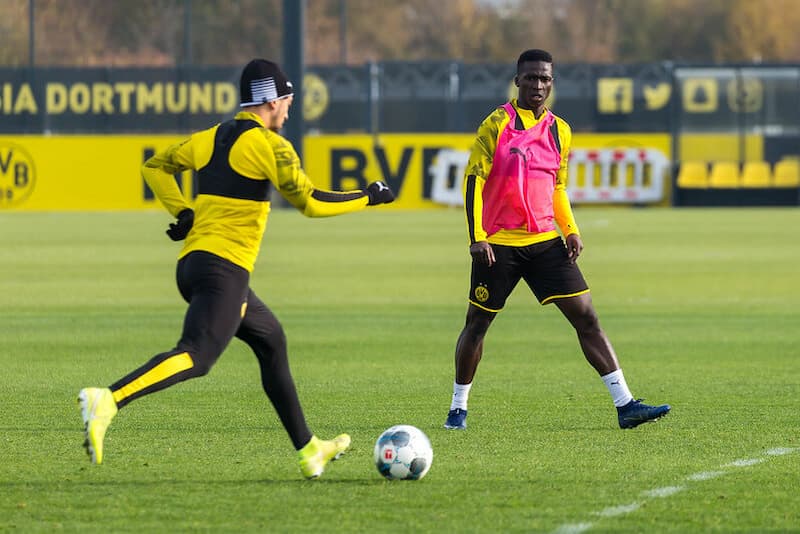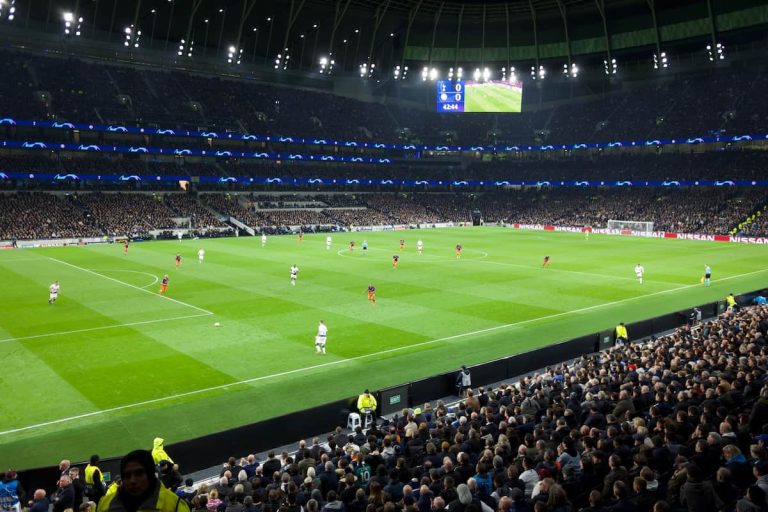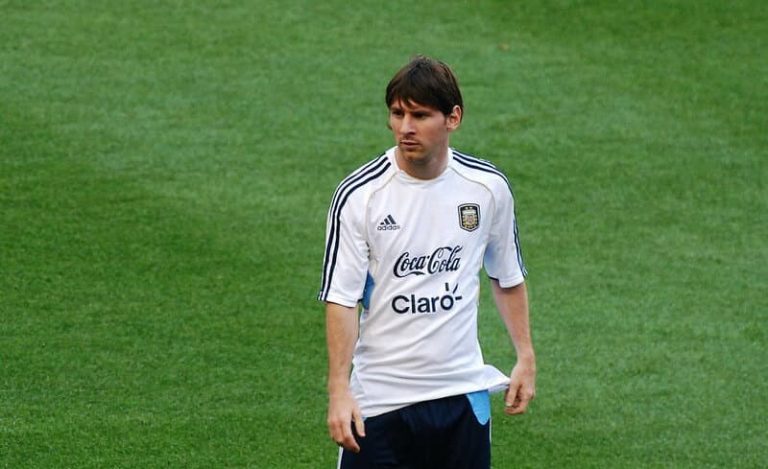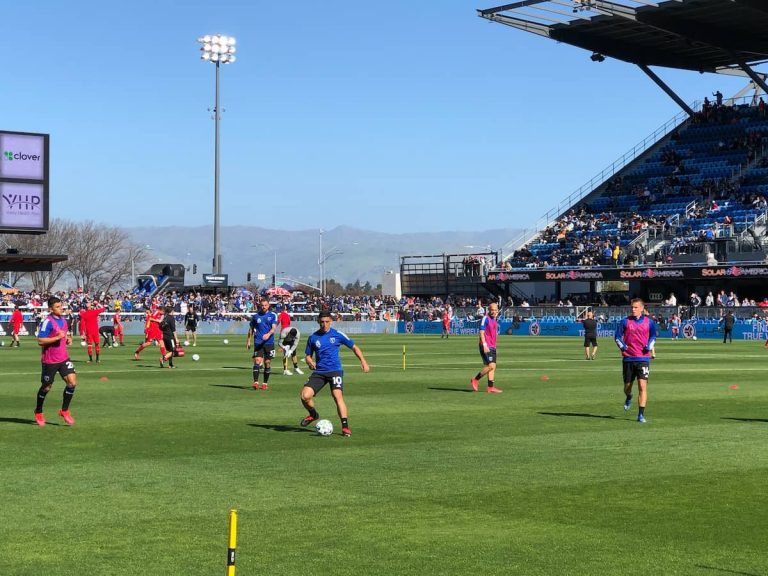Why Do Footballers Wear Vests?

If you’ve ever witnessed a footballer wearing a short black vest during a training session or a match, you’ve probably wondered why they are wearing it. These vests can easily be mistaken for sports bras, but instead of being worn for support, they’re actually worn for different reasons.
In this article, we’re going to explain the different reasons why footballers wear vests, including to maximise performance levels, to avoid injuries and to provide teams with tactical advantages. We’ll also discuss the benefits and drawbacks of players wearing vests.
Table of Contents
Why Do Footballers Wear Vests?
Footballers wear GPS vests so that their coaches can monitor a number of metrics that analyse a player’s performance. A vest enables a player to comfortably wear the GPS tracking software, similar to what you’d find in a smartwatch. Some useful metrics monitored by these vests are:
- Distance Ran
- Speed
- Heart Rate
- Acceleration
- Metres per Minute
What Is a GPS Vest?
A GPS vest is a device worn by football players during training sessions and matches. It is equipped with Global Positioning System (GPS) technology and tracks several metrics relating to a player’s movement.
Why Do Footballers Wear Vests in Training?
Footballers wear vests in training for the same reasons they wear them during matches. GPS vests allow football coaches to monitor their performance closely, and this data can be used to make informed decisions, including whether that player is fit to start the next match.
Coaches can use the data collected by GPS vests to see whether a training drill is too intense for the session or not. They’ll look at certain metrics, including meters per minute, heart rate and acceleration, to judge this. They can also use these metrics to monitor players regarding injuries, for example a player exerting too much acceleration during a training session might be at risk of a potential hamstring injury.
This video from Crystal Palace Football Club covers some of the reasons why footballers wear GPS vests during training sessions:
How Are GPS Vests Used in Football?
GPS vests have become a regular part of modern day football. They’re a piece of equipment worn by players during training sessions and matches.
The data collected by each GPS vest is transmitted wirelessly in real time to a computer, tablet or mobile device. This can then be analysed by football coaches in order to make informed decisions about training and match tactics.
Benefits of Using GPS Vests in Football
The reason why football clubs get their players to wear GPS vests is because there are many benefits from doing so. It may seem like a small piece of equipment, but the data collected from players wearing them is often really insightful for clubs and managers.
Four of the main benefits of footballer’s wearing vests are improved performance tracking, injury prevention, tactical advantages and post-match analysis.
Improved Performance Tracking
Why do footballers wear vests? The main reason why, is to improve performance tracking. Before GPS vests, coaches and managers would rely on the eye-test to monitor performances, i.e. cast a judgement from what they see in order to make decisions.
For example, if a player is running slower and physically look exhausted, the manager might think that it’s a good idea to replace them with another player. Data collected from GPS vests can now tell coaches this information before it’s too late. This applies for scenarios when the “eye-test” isn’t able to make those judgements.
Coaches can use the data collected by GPS vests to monitor a player’s performance during training sessions over a number of weeks. Historical data can then be compared to see if a player’s performances are improving in those drills or not. This can be applied to match performances, too.
GPS vests will be heavily used during pre-season by football clubs. After teams take some time away from playing matches during the summer, players fitness levels decrease. As soon as pre-season training begins, GPS vests can start tracking an individual player’s data as they start regaining their fitness. This can be a great indicator to see which players are fit enough to start the first match of the season.
Injury Prevention
Another reason why footballers wear GPS vests is to prevent injuries. The metrics collected by the GPS technology can inform coaches when a player is potentially experiencing too much intensity during a training session or match. If a coach is alerted to a player with potential fatigue in a training session, they’ll be able to withdraw them from the drill before they experience an injury.
A metric such as acceleration can be directly related to hamstring injuries. The more acceleration a player experiences in one session, the harder their hamstrings are having to work, which may cause them an injury.
GPS vests allow football coaches to monitor data relating to a player’s specific injury concerns, too. For example, if a player has a track record of hamstring injuries, coaches will monitor any metrics relating to a potential hamstring injury closely. This helps protect players from getting injured again, and keeps the overall squad fitness at a higher level throughout a season.
Tactical Advantages
Another reason why footballers wear vests is to help football clubs gain tactical advantages. Data collected when footballers wear GPS vests helps coaches understand a player’s positional play during training sessions and matches. They’ll learn whether their positional play compliments the manager’s strategy.
The most tactical football managers require their players to be extremely disciplined in positional play and through their tactical behaviour on the pitch. The information obtained from GPS data can help managers make informed decisions on which players they should select for the next match.
They’ll also use the information to design a training regime that optimises performance levels. Training regimes will be designed to compliment and improve the tactical strategy that managers want their team to play.
Post-Match Analysis
The data collected when footballers wear vests will contribute to post-match analysis too. As the majority of football clubs now use data to make lots of informed decisions, GPS vests are crucial when conducting post-match analysis.
Certain metrics such as distance covered informs a coach whether an individual player has worked hard during a match. Each position will have its own targets when it comes to metrics, as the requirements vary across the pitch. Coaches will compare actual data against these targets to communicate with players whether they’ve performed well or not.
The data provided by GPS vests can be helpful for coaches and players when discussing what they might need to do differently in the next match.
Criticisms and Limitations of GPS vests
There are however different criticisms and limitations of GPS vests in football. These include cost, accuracy, interference, comfort, data overload, maintenance and ethical concerns.
Cost
Purchasing GPS vests for a full squad of players can be an expensive investment. Although, this is not likely to be a problem for any of the big clubs, smaller clubs who play in the lower tiers of football might not be able to afford the equipment.
This means that they won’t be able to experience any of the benefits we discussed earlier, making it harder for them to make significant progress up the leagues.
Accuracy
The satellite signals required for GPS vests to work can easily be affected by environmental factors including trees, extreme weather conditions, as well as large buildings. Factors like these can reduce the accuracy of the data collected by the vests.
Interference
It’s possible that other smart devices, including phones, smartwatches and general Wi-Fi signals can interfere with GPS data collection. This is something to bear in mind, as it affects the validity of the data.
Comfort
Some footballers don’t enjoy wearing GPS vests in training and matches, as they find them uncomfortable. This can affect their performance negatively, which football clubs don’t want.
Data Overload
The masses of data collected by GPS vests can mean that it’s a time-consuming process for the coaches to draw meaningful insights. With football clubs regularly playing two matches a week, there isn’t much time to understand the data in order to make tactical tweaks.
Maintenance
GPS vests will need to be regularly maintained, and will regularly need their batteries charging or replaced. This in time can become frustrating for the coaches and support staff.
Ethical Concerns
Like with any kind of technology, there are some slight ethical concerns with footballers wearing GPS vests. Because the vests are able to monitor a player’s movements both on and off the pitch, a footballer’s privacy could be at stake.
Conclusion
GPS vests are another form of football data collection that football clubs are finding useful in the modern game. The ability to reduce the risk of injury, monitor performance levels closely and potentially gain tactical advantages is a no-brainer for clubs when every marginal gain is crucial in football.
Since 2019, when football players were given the all clear to wear GPS vests during matches, coaches and managers have been able to conduct even further analysis into player performance. The ability to assess a player’s performance in training in comparison to a match can help identify strengths and weaknesses in their play, which will inevitably make them a better player in time.
There are however some downsides to this technology, including cost, accuracy and interference, but in the case of most football teams, the benefits outweigh the drawbacks regarding the use of GPS vests in football.
Frequently Asked Questions
Do Footballers Wear Sports Bras?
No, footballers wear GPS vests, these serve a different purpose to sports bras. GPS vests are solely worn to track player performance data.
Why Don’t Footballers Wear Smartwatches Instead?
There are two main reasons why footballers wear GPS technology via a vest:
– It’s been proven to be the safest way for sportspeople to wear the technology. For example, if they wore it on their wrist as a watch, this could be dangerous for opposition players during collisions in matches.
– It’s also the most optimal position for the GPS technology to be in relation to GPS satellites. Having a better connection means that data has a higher chance of being accurate and reliable.Are GPS Vests Only Used in Football?
No, GPS vests are used in a range of team sports, including American Football (NFL), Rugby, Basketball and Cricket.
When Did Footballers Start Wearing Vests in Matches?
In 2019, GPS vests were approved to be worn during football matches. Prior to this, they would only be worn in training sessions. This was a great outcome for football clubs as they could start closely monitoring player performance during matches, where players usually give their maximum effort.
Where Is the GPS Unit Located in GPS Vests?
The GPS unit is located on the back of a GPS vest, directly in-between a player’s shoulder blades.






